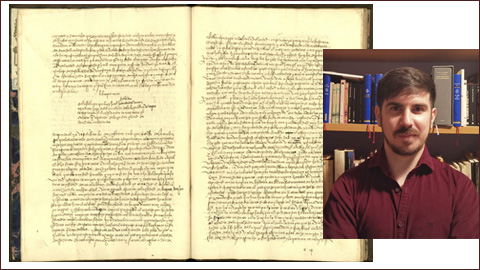First full translation of Thomas More's Utopia identified: into Spanish and to be used in America

A PhD thesis presented by Víctor Lillo Castañ has determined the author, Vasco de Quiroga, and the date, circa 1530, of the first full translation into a vernacular language of Thomas More's Utopia in an unpublished manuscript preserved at the Royal Palace Library in Madrid.
The first full translation of Thomas More's Utopia was into Spanish, and it was translated by Vasco de Quiroga, the first bishop of Michoacan, who also used the text to politically organise two indigenous communities of Mexico in 1530. This is the conclusion reached by the PhD thesis defended by Víctor Lillo Castañ at the Universitat Autònoma de Barcelona (UAB).
The researcher demonstrated that the translation of Utopia by Vasco de Quiroga had not been lost, as was thought, but that it had been preserved in a manuscript in the Royal Palace Library in Madrid, which is managed by Spain's National Heritage. The translation was anonymous and did not present a date in which it was done. Despite the library's catalogue includeing the text since 1992, no one had managed to date the text or identify the author, and the work had almost gone unnoticed until now.
Lillo Castañ, who has been the first person to edit the text, demonstrates that the translation is the one announced by Vasco de Quiroga in a report to the Council of the Indies which dates back to somewhere between 1532 and 1535. A relevant date, which confirms that the Spanish version is the first translation of the work into a vernacular language and a far earlier translation than that of Jerónimo Antonio de Medinilla, published in 1637, which only contains Book II and traditionally was considered to be the first translation into Spanish of Thomas More's Utopia.
“There now has been a notable turn in events considering the knowledge about the effects Utopia had in Spain. Until now, it was thought that Thomas More's work had had a rather lately and weak resonance”, says Joan Curbet, lecturer at the UAB and secretary of the tribune evaluating Lillo Castañ's PhD thesis.
The translation identified is a complete version of the text, based on the 1519 edition published in Florence. The only other earlier translation known to exist is one into German dating back to 1524, which only includes Book II.
The Research
Víctor Lillo Castañ identified the authorship of Vasco de Quiroga after reading a text written by him in Mexico in 1535, which he sent to a member of the Council of the Indies. In the letter, he stated that he had founded two villages inhabited by indigenous people who ruled themselves according to laws very similar to those described in Thomas More's Utopia.
In this report, currently preserved in the Spanish National Library (BNE, Mss/ 7369), Quiroga mentioned that he was attaching his translation of the work so that his social organisation plan could be better understood. However, the translation is not part of the manuscript preserved in the BNE and was therefore thought to be lost.
“According to the handwriting of the two transcribers and an indicator within the text, we can date the text without a doubt to the time of Charles V, approximately in the 1530s. When compared to the Latin text of Utopia, the Spanish translation is very loyal to the original text, and differs in terms only a handful of times”, the researcher points out.
“Víctor Lillo has tied two ends together: the anonymous Spanish translation located in the Royal Palace Library and Vasco de Quiroga's report, and he has demonstrated with his PhD that there is no doubt that the manuscript is the translation Vasco mentioned in his report”, remarks UAB lecturer María José Vega,who directed his thesis.
A Utopia to be implemented in 16th-century Mexico
Thomas More wrote Utopia in Latin so that it could be read by intellectuals of the Cinquecento period, and named it De optimo reipublicae statu deque nova insula Vtopia, which translates into “about the best system of governance and about the island of Utopia”, a title that is no longer added in more modern versions.
“The great irony of the book, which combines mockery and truth in proportions which are difficult to determine., consists in the fact that utopia is a word invented by More based on the Greek prefix “ou-”, meaning “no”, and “-topos”, meaning “place”, so that the literal translation of the term would be no-place. Nevertheless, Vasco de Quiroga was fascinated when he read Thomas More's work and, contrary to the scepticism revealed by the title, he saw it as a project that could be put into practice in the New Spain, 16th century Mexico”, explains Víctor Lillo Castañ.
Vasco founded two indigenous communities, in Mexico and in Michoacan, and gave them the names of Santa Fe de Mexico and Santa Fe de la Laguna.
“The most notable trait of these communities is that they abided by laws that were almost identical to those in Utopia. Vasco created these two villages, which he aimed to multiplicate throughout New Spain, to prevent the conquistadors and colonisers from forcing the natives into slavery and also to educate them in the Christian faith”, the researcher states.
Víctor Lillo Castañ read his PhD thesis, entitled “Vasco de Quiroga y la Utopia de Tomas Moro en Nueva España: estudio y edición del manuscrito II/1087 de la Real Biblioteca del Palacio Real de Madrid”, this past July as part of the UAB Spanish Studies PhD Programme, awarded with a mention of excellence.

